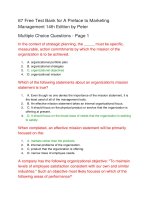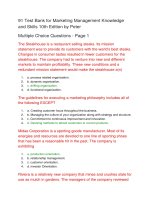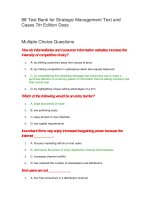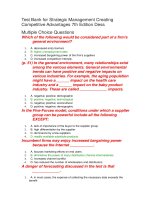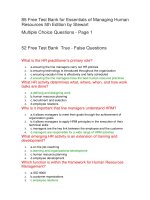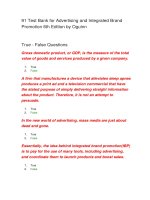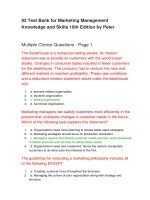Test bank for kinns the administrative medical assistant 7th edition by young
Bạn đang xem bản rút gọn của tài liệu. Xem và tải ngay bản đầy đủ của tài liệu tại đây (39.23 KB, 4 trang )
buy this full document at
Young: Kinn's The Administrative Medical Assistant, 7th Edition
Chapter 01: Becoming a Successful Student
Test Bank
COMPLETION
1. Medical assistants play a vital role in the healthcare team and are expected to display
such __________ as dependability, respectful patient care, empathy, initiative, positive
attitude, and teamwork.
ANS:
professional behaviors
Professional behaviors are actions that identify the medical assistant as a member of the
healthcare profession.
PTS: 1
2. Learning styles are determined by your individual method of __________, or examining,
new material and the way you process it or make it your own.
ANS:
perceiving
Perceiving is the method individuals use to examine information and recognize it as real.
PTS: 1
3. __________ can evaluate conflicting information and make a decision to act based on
their knowledge and willingness to be open minded about all possibilities.
ANS:
Critical thinkers
Critical thinking involves considering all aspects of a situation when making decisions or
before taking action.
PTS: 1
REF: Affect: I. 1. Apply critical thinking skills in performing patient assessment and
care
4. Learning __________ are the ways that you like to learn and that have proven successful
in the past.
ANS:
preferences
Learning preferences determine individual learning methods.
PTS: 1
5. Problem solving and __________ management techniques are keys to your success.
ANS:
conflict
Conflict management involves attempting to resolve an issue in a private place, clearly
stating your feelings about the situation, and working together to reach a solution.
PTS: 1
6. The first step to reaching a solution to a problem or conflict is to identify the
__________.
ANS:
buy this full document at
Full file at />
7.
8.
9.
10.
problem
central issue
The cause of the conflict must be identified before solutions can be researched.
PTS: 1
Methods for determining possible solutions to a conflict are to brainstorm or to make a(n)
__________ list.
ANS:
pros and cons
Developing a pros and cons list helps the individual identify possible solutions.
PTS: 1
Once you have decided on a solution to the problem, it is essential to __________ the
outcomes of your solution and decide whether it solved the problem or whether another
approach should be tried.
ANS:
evaluate
Evaluating the outcome of the attempted solution helps determine whether it is the
correct one or whether an alternate solution should be tried.
PTS: 1
__________ allows you to express your thoughts and feelings honestly and enables you
to stand up for yourself in a reasonable and rational manner without an emotional scene.
ANS:
Assertive communication
Assertive communication enables us to be honest and direct with others while at the same
time being emotionally honest with ourselves. The goal of assertive behavior is to treat
others with respect while acknowledging our own feelings about the problem.
PTS: 1
REF: Cog: IV. 15. Discuss the role of assertiveness in effective professional
communication
Creating a(n) __________ can be an effective way to represent the main idea of the topic
and its important details with a figure or picture.
ANS:
mind map
Mind maps help learners organize and visualize more complex material.
PTS: 1
MATCHING
Match each term with the correct definition.
a. Learning style
e. Empathy
b. Reflection
f. Perceiving
c. Professional behaviors
g. Critical thinking
d. Processing
1. The constant practice of considering all aspects of a situation in deciding what to believe
or what to do
Copyright © 2011 by Saunders., an affiliate of Elsevier Inc.
Full file at />2. Those actions that identify the medical assistant as a member of a healthcare profession,
including dependability, respectful patient care, initiative, positive attitude, and teamwork
3. The way an individual looks at information and sees it as real
4. The way an individual perceives and processes information to learn new material
5.
The way individuals internalize new information and make it their own
6. The process of considering new information and internalizing it to create new ways of
examining information
7. Sensitivity to the individual needs and reactions of patients
1. ANS: G
PTS: 1
REF: Affect: I. 1. Apply critical thinking skills in performing patient assessment and
care | Affect: IV. 1. Demonstrate empathy in communicating with patients, family and
staff
2. ANS: C
PTS: 1
3. ANS: F
PTS: 1
4. ANS: A
PTS: 1
5. ANS: D
PTS: 1
6. ANS: B
PTS: 1
7. ANS: E
PTS: 1
SHORT ANSWER
1. Summarize three time-management strategies that can help you put time on your side.
ANS:
Any of the following: determine your purpose, identify your main concern, plan time, use
downtime, guard time, discover time, assign time, be organized, record time, optimize
time, stop procrastinating, remember you.
PTS: 1
REF: Cog: V. 13. Identify time management principles
2. Identify and explain four study skills that can help you become a successful student.
ANS:
Any of the following explanations: organize information into recognizable groups so that
your brain can remember it more easily; be physically active while studying; create
pictures of the material or rewrite notes; overlearn material you find anxiety producing;
create songs, word associations, or dances; teach the material to someone else; read
assignments more than once; take effective notes; ask questions about material you do not
understand; review your notes shortly after class; create mind maps; adopt a positive
attitude about your success.
PTS: 1
3. Describe three strategies that can help you become successful at taking tests.
ANS:
Prepare adequately, control negative thoughts during test time, and understand how to
manage different types of questions.
PTS: 1
4. Summarize the characteristics of nonassertive communication.
ANS:
Copyright © 2011 by Saunders., an affiliate of Elsevier Inc.
Full file at />Keeping the eyes downcast, shifting one’s weight when talking, slumping the shoulders
or wringing the hands, whining or using a hesitant tone of voice. Also, using terminology
such as “maybe,” or “I guess,” “I wonder if you could,” “Would you mind very much if,”
or “It’s not really important.”
PTS: 1
REF: Cog: IV. 15. Discuss the role of assertiveness in effective professional
communication
5. Summarize the characteristics of aggressive communication.
ANS:
Leaning forward and pointing a finger when talking, raising the voice or sounding
arrogant, using terminology such as, “You’d better,” “If you don’t watch out,” “Do it or
else,” or “You should do it this way.”
PTS: 1
REF: Cog: IV. 15. Discuss the role of assertiveness in effective professional
communication
6. You are facing a situation in which you must act assertively to solve a problem.
Summarize below the steps you should use in delivering an assertive message.
ANS:
Choose a feeling word that describes how you feel about the situation; think about the
specific situation that must be described; form an “I” sentence with the appropriate
feeling word and specific description of the circumstances. Then, establish eye contact,
raise one’s voice slightly, if necessary, to get the individual’s attention, and deliver the “I”
sentence.
PTS: 1
REF: Cog: IV. 15. Discuss the role of assertiveness in effective professional
communication
Copyright © 2011 by Saunders., an affiliate of Elsevier Inc.
